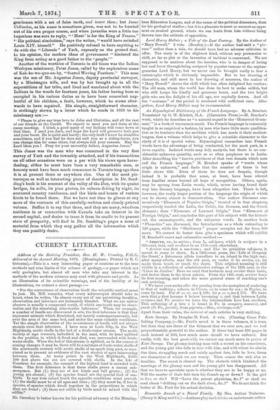CURRENT LITERATURE.
Address of the Retiring President, Rev. H. W. Crosskey, F.G.S., delivered at the Annual Meeting, 1873. (Birmingham : Printed by E. C.
Osborne).—This is a very interesting paper of cautions as to the true methods and true limits of the science of geology,—a paper which not only geologists, but almost all men who take any interest in the methods of the modern sciences may read with pleasure and profit. As an illustration of its scientific warnings, and of the lucidity of its illustrations, we extract a short passage :—
"For the correctness of observation itself the scientific method must be just. Mr. Mill remarks, what every microscopist should take to heart, when he writes, 'In almost every act or our perceiving faculties, observation and inference are intimately blended. What we are said to observe is usually a compound result, of which one-tenth may be obser- vation and the remaining nine-tenths inference.' When, for example, a number of fossils are discovered in situ, the first inference is that they represent animals which flourished, not merely contemporaneously, but over the area of the same bed, and under the same climatic conditions. Yet the simple observation of the co-existence of fossils will not always sustain even that inference. I have seen at Loch Gilp, in the West Highlands, arctic shells in the bed of a fresh-water stream. The arctic variety of mite truncate, imbedded in the rand, with its head uplifted in the position in which it lived and died, was surrounded with fresh- water shells. When the bed of this stream is uplifted, as in the course of coming changes it maybe, there will be a mixture of fresh-water shells of the nineteenth century with arctic shells of an epoch long past, so asso- ciated as to present no evidence of the vast stretch of ages intervening between them. At many points in the West Highlands, fields 100 feet above the sea are covered with shells. In the Isle of Cumbrae for example, the summit of the highest land is crowded with them. The first inference is that these shells prove a recent sub- mergence. But (1) they are of few kinds and full grown ; (2) the young are absent ; (3) the species found are the special food of sea- birds. In any true raised beach the opposite conditions must prevail. (1) the shells must be of all ages and sizes ; (2) they must be, if few in species, otspecies which dwell together in the proportions in which they are found ; (3) those not edible by birds must be mixed with the edible."
Mr. Crosekey is better known for his Political advocacy of the Binning- (Henry S. King and Co.)—Authors play such tricks on unfortunate critics
ham Education League, and of the cause of the political dissenters, than for his geological studies ; but it is a pleasure to meet so earnest an oppo- nent on neutral ground, where we can learn from him without being thrown into the attitude of opposition.


































 Previous page
Previous page